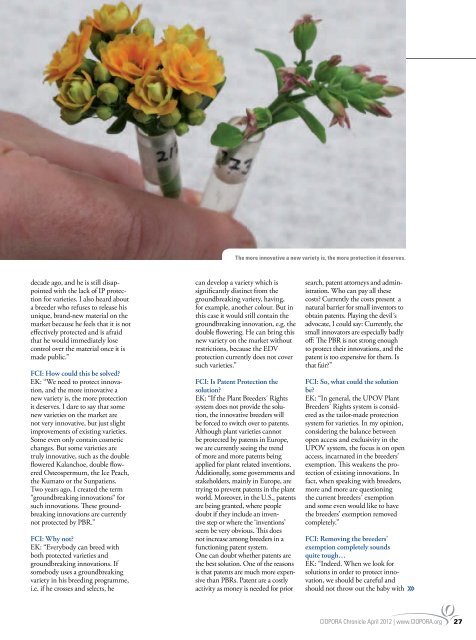2012 CIOPORA Chronicle
CIOPORA annual magazine on Intellectual Property protection for plant innovations 2012. The magazine was produced in cooperation with FloraCulture International. Read in the 2012 CIOPORA Chronicle edition: - Plant Patents in the United States after the America Invents Act - U.S. plant patents compared to UPOV PBR system - Does Belgian patent law need a breeder’s exemption? - How much open access can breeders afford? - IPP and PBR in Chile - IP protection for plant innovations in Canada and much more...
CIOPORA annual magazine on Intellectual Property protection for plant innovations 2012. The magazine was produced in cooperation with FloraCulture International.
Read in the 2012 CIOPORA Chronicle edition:
- Plant Patents in the United States after the America Invents Act
- U.S. plant patents compared to UPOV PBR system
- Does Belgian patent law need a breeder’s exemption?
- How much open access can breeders afford?
- IPP and PBR in Chile
- IP protection for plant innovations in Canada
and much more...
Create successful ePaper yourself
Turn your PDF publications into a flip-book with our unique Google optimized e-Paper software.
The more innovative a new variety is, the more protection it deserves.<br />
decade ago, and he is still disappointed<br />
with the lack of IP protection<br />
for varieties. I also heard about<br />
a breeder who refuses to release his<br />
unique, brand-new material on the<br />
market because he feels that it is not<br />
effectively protected and is afraid<br />
that he would immediately lose<br />
control over the material once it is<br />
made public.”<br />
FCI: How could this be solved?<br />
EK: “We need to protect innovation,<br />
and the more innovative a<br />
new variety is, the more protection<br />
it deserves. I dare to say that some<br />
new varieties on the market are<br />
not very innovative, but just slight<br />
improvements of existing varieties.<br />
Some even only contain cosmetic<br />
changes. But some varieties are<br />
truly innovative, such as the double<br />
flowered Kalanchoe, double flowered<br />
Osteospermum, the Ice Peach,<br />
the Kumato or the Sunpatiens.<br />
Two years ago, I created the term<br />
“groundbreaking innovations“ for<br />
such innovations. These groundbreaking<br />
innovations are currently<br />
not protected by PBR.”<br />
FCI: Why not?<br />
EK: “Everybody can breed with<br />
both protected varieties and<br />
groundbreaking innovations. If<br />
somebody uses a groundbreaking<br />
variety in his breeding programme,<br />
i.e. if he crosses and selects, he<br />
can develop a variety which is<br />
significantly distinct from the<br />
groundbreaking variety, having,<br />
for example, another colour. But in<br />
this case it would still contain the<br />
groundbreaking innovation, e.g. the<br />
double flowering. He can bring this<br />
new variety on the market without<br />
restrictions, because the EDV<br />
protection currently does not cover<br />
such varieties.”<br />
FCI: Is Patent Protection the<br />
solution?<br />
EK: “If the Plant Breeders´ Rights<br />
system does not provide the solution,<br />
the innovative breeders will<br />
be forced to switch over to patents.<br />
Although plant varieties cannot<br />
be protected by patents in Europe,<br />
we are currently seeing the trend<br />
of more and more patents being<br />
applied for plant related inventions.<br />
Additionally, some governments and<br />
stakeholders, mainly in Europe, are<br />
trying to prevent patents in the plant<br />
world. Moreover, in the U.S., patents<br />
are being granted, where people<br />
doubt if they include an inventive<br />
step or where the ‘inventions’<br />
seem be very obvious. This does<br />
not increase among breeders in a<br />
functioning patent system.<br />
One can doubt whether patents are<br />
the best solution. One of the reasons<br />
is that patents are much more expensive<br />
than PBRs. Patent are a costly<br />
activity as money is needed for prior<br />
search, patent attorneys and administration.<br />
Who can pay all these<br />
costs? Currently the costs present a<br />
natural barrier for small inventors to<br />
obtain patents. Playing the devil´s<br />
advocate, I could say: Currently, the<br />
small innovators are especially badly<br />
off: The PBR is not strong enough<br />
to protect their innovations, and the<br />
patent is too expensive for them. Is<br />
that fair?”<br />
FCI: So, what could the solution<br />
be?<br />
EK: “In general, the UPOV Plant<br />
Breeders´ Rights system is considered<br />
as the tailor-made protection<br />
system for varieties. In my opinion,<br />
considering the balance between<br />
open access and exclusivity in the<br />
UPOV system, the focus is on open<br />
access, incarnated in the breeders’<br />
exemption. This weakens the protection<br />
of existing innovations. In<br />
fact, when speaking with breeders,<br />
more and more are questioning<br />
the current breeders´ exemption<br />
and some even would like to have<br />
the breeders’ exemption removed<br />
completely.”<br />
FCI: Removing the breeders’<br />
exemption completely sounds<br />
quite tough…<br />
EK: “Indeed. When we look for<br />
solutions in order to protect innovation,<br />
we should be careful and<br />
should not throw out the baby with >>><br />
<strong>CIOPORA</strong> <strong>Chronicle</strong> April <strong>2012</strong> | www.<strong>CIOPORA</strong>.org 27









